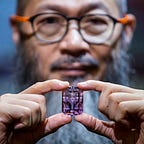Embracing Crisis in the Age of Change
Can artists be replaced? This is a question on the minds of many creatives. These days, it’d be rare for it not to be asked during discussions of my work.
The ongoing rise of Artificial Intelligence, virtual reality and other technologies concerns those both in and outside the art world. Considering my profession involves creativity and craftsmanship, many want to know: Do I perceive technology as a threat?
I would only fear technology if I feared change. My life’s challenges have taught me that change is a good thing. True progress occurs when we embrace change.
With that said, machines replacing human beings is certainly nothing new. The rate and scale of A.I.’s transformative effect on the market may seem alarming, but the truth is, people get replaced all the time, and often not by robots but other humans. As everything is bound to be replaced, the question is only when. In the face of fast-paced and radical changes, we must follow our most important internal compass: our sense of crisis.
In the animal world, there is often a thin line between life and death that hinges on survival instincts. Crises trigger human survival instincts as well. In my experience, what drives me to create is not mere curiosity but knowing that the only way to stay ahead is to compete against the currents of an era — not time. I work to outsmart myself, not others.
When you are competing against time, your goal is to become the fastest. When competing against the currents of an era, you aim at making the best of your own life. Outsmarting others may bring momentary satisfaction, but outsmarting yourself manifests a better version of yourself. No matter how fast the world is changing, we must first cultivate our own sense of being to avoid running like a senseless chicken.
At age sixteen, my sense of crisis prompted me to become a carver. To survive in Hong Kong, where there were more people than jobs, I knew I had to acquire a skill. Forty-five years have now passed, but the same urgency continues to fuel my drive. Every time I complete a work, I forbid myself from dwelling on it. I dive into a new creation immediately after. My sense of crisis, now a permanent part of my being, reminds me that lingering too long in the garden of old successes bars new seeds from blossoming.
While creativity and craftsmanship remain key to my works, I constantly challenge myself to enhance my understanding and application of new technologies. So far, I have seen more good than bad. First, new technologies free time and space for the artist to focus on deep work by eliminating shallow tasks and repetitive processes. Secondly, the elimination process is a valuable source of inspiration; technology as an imaginative enemy tells us what we ought to do and do better. For instance, forms and functions are bonding better than ever as technology has opened doors to new mechanisms that elevate the wearability of a piece and its comfort for the wearer. Our sense of crisis helps us to sharpen our focus and anticipate the next obstacle to conquer.
As a Chinese saying goes, “Fish know nothing of the sky, and birds know nothing of the ocean.” My take on this is to transcend the boundaries — be the fish that knows the sky, and the bird that knows the ocean.
